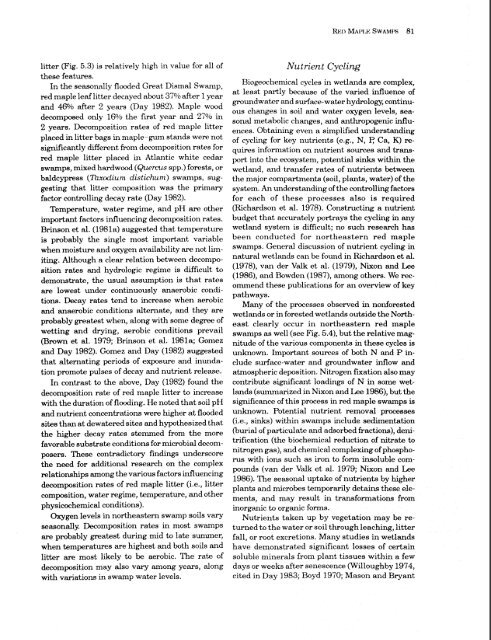Ecology of Red Maple Swamps in the Glaciated Northeast: A ...
Ecology of Red Maple Swamps in the Glaciated Northeast: A ...
Ecology of Red Maple Swamps in the Glaciated Northeast: A ...
Create successful ePaper yourself
Turn your PDF publications into a flip-book with our unique Google optimized e-Paper software.
li&r (Fig. 6.3) is relatively high <strong>in</strong> value for all <strong>of</strong><br />
<strong>the</strong>se features.<br />
In <strong>the</strong> seasonally fiooded Gwat Dismd SWmlp,<br />
red maple leaf litter decayed about 37% after 1 year<br />
and 46% after 2 yem (Day 1982). <strong>Maple</strong> wood<br />
decomposed only l6O.0 <strong>the</strong> first year and 27Oio <strong>in</strong><br />
2 years. hn~position raks <strong>of</strong> md maple litter<br />
placed <strong>in</strong> litter bags <strong>in</strong> maple -gun1 stmlds were not<br />
significantly different from decomposition rates for<br />
red maple litter placed <strong>in</strong> Atlantic white cedw<br />
swamps, mixed hardwood (Qu~nus spp.) forests, or<br />
baldcypress (Tlzxdurn distkhunr) swmlps, suggest<strong>in</strong>g<br />
that litter composition was <strong>the</strong> primary<br />
fador controll<strong>in</strong>g decay rate (Day 1982).<br />
Temperature, water regime, and pH ~1.e o<strong>the</strong>r<br />
impsrtant factors <strong>in</strong>fluenc<strong>in</strong>g deconipositioxl rates.<br />
Brimon et d. (1981a) suggested that temperature<br />
is probably <strong>the</strong> s<strong>in</strong>gle most imlwrta~x.t variable<br />
when moisture and oxygen availability are not limit<strong>in</strong>g.<br />
Although a clear relation betweexl decomposition<br />
rates and hydrologic regime is difficult to<br />
demonstrate, <strong>the</strong> usunl assumption is that rates<br />
are lowest under conti~luously anaerobic conditions.<br />
hay rates tend to ir~crease when aerobic<br />
and anaerobic conditions alhrr~ate, md <strong>the</strong>y are<br />
probably greatest when, dong with some degree <strong>of</strong><br />
wett<strong>in</strong>g and dry<strong>in</strong>g, aerobic conditions prevail<br />
(Brown et al. 1979; Br<strong>in</strong>son et al. 1981a; Gomez<br />
and Day 1982). Gomez nnd Day (1982) suggested<br />
that alternat<strong>in</strong>g periods <strong>of</strong> exposure md <strong>in</strong>undation<br />
promote pulses <strong>of</strong> decay and nutrient release.<br />
In contrast ta <strong>the</strong> above, Day (1982) found <strong>the</strong><br />
decomposition rate <strong>of</strong> red maple litter to <strong>in</strong>crease<br />
with <strong>the</strong> duration <strong>of</strong> flood<strong>in</strong>g. IIe noted that soil pH<br />
and nutrient concentrations were higher at flooded<br />
sites than at dewatered sites and hypo<strong>the</strong>sized that<br />
<strong>the</strong> higher decay rates stemmed from <strong>the</strong> more<br />
favorable substrate conditions for microbial deconlposers.<br />
These contradictory furd<strong>in</strong>gs underscore<br />
<strong>the</strong> need for additional research on <strong>the</strong> complex<br />
relationships among <strong>the</strong> various factors <strong>in</strong>fluenc<strong>in</strong>g<br />
decomposition rates <strong>of</strong> red maple litter (i.e., litter<br />
composition, water regime, temperature, and o<strong>the</strong>r<br />
physicochemical conditions).<br />
Oxygen levels <strong>in</strong> nor<strong>the</strong>astern swamp soils vary<br />
seasonally. Decomposition rates <strong>in</strong> most swamps<br />
are probably greatest durixg mid Lo late summer,<br />
when temperatures are highest and both soils arrd<br />
litter are most likely to be aerobic. The rak <strong>of</strong><br />
decomposition may dso vary among years, along<br />
with variatiom <strong>in</strong> swamp water levels.<br />
Nu tricnt Cycl<strong>in</strong>g<br />
Biovhenlical cycles <strong>in</strong> wetlmds RIP. conlplex,<br />
at least partly <strong>of</strong> <strong>the</strong> varied <strong>in</strong>fluence <strong>of</strong><br />
groundwakr and surface-water hydrology, cont<strong>in</strong>uous<br />
changes irr soil and water oxygen levels, seasorld<br />
metabolic changes, arid mthropogenic <strong>in</strong>fluences.<br />
Obta<strong>in</strong><strong>in</strong>g even a simplified \u>derstand<strong>in</strong>g<br />
<strong>of</strong> cyclixlg for key nutrients (e.g., N, 1: Ca, K) requires<br />
<strong>in</strong>fornlatioxz on nutrient soilrces mid trwmport,<br />
<strong>in</strong>to <strong>the</strong> ecosystem, potential s<strong>in</strong>ks with<strong>in</strong> <strong>the</strong><br />
wetland, m~d transfer rates <strong>of</strong> nutrients between<br />
<strong>the</strong> major compartments (soil, plant^, water) <strong>of</strong> <strong>the</strong><br />
system. An understsuld<strong>in</strong>g <strong>of</strong> <strong>the</strong> controIl<strong>in</strong>g factors<br />
for each <strong>of</strong> <strong>the</strong>se processes also is required<br />
@ichwirdson et a1. 1978). Construct<strong>in</strong>g a nutrient<br />
budget that accurately prt;rays <strong>the</strong> cycl<strong>in</strong>g <strong>in</strong> any<br />
wetlmd system is difficult; no such research has<br />
been conducted for nor<strong>the</strong>astern red maple<br />
swamps. General discussion <strong>of</strong> nutrient cycl<strong>in</strong>g <strong>in</strong><br />
natural wetlands can be? foilnd <strong>in</strong> Richardsox~ et al.<br />
(1978)) van der Valk et d. (1979), Nixon and IAX.<br />
(1986), and Bowden (19871, among o<strong>the</strong>rs. We reconunend<br />
<strong>the</strong>se publications for an overview <strong>of</strong> key<br />
pathways.<br />
Many <strong>of</strong> <strong>the</strong> processes observed <strong>in</strong> nonfowsled<br />
wetlands or <strong>in</strong> forested wetlmds outside <strong>the</strong> Nor<strong>the</strong>ast<br />
clearly occur <strong>in</strong> nor<strong>the</strong>astern red maple<br />
sw~nlps as well (see Fig. 5.4), but tile relative magnitude<br />
<strong>of</strong> <strong>the</strong> various cloxnponents <strong>in</strong> <strong>the</strong>se cycles is<br />
u*kxlown. Important sources <strong>of</strong> both N and P <strong>in</strong>clude<br />
surface-water and grot~ndwater <strong>in</strong>flow and<br />
atmospheric deposition. Nitrogen fixation also may<br />
contribute significant load<strong>in</strong>gs <strong>of</strong> N <strong>in</strong> some wet-<br />
lands (surxun~arized <strong>in</strong> Nixon and Lee I%), but <strong>the</strong><br />
significance <strong>of</strong> this process <strong>in</strong> red maple swamps is<br />
urhowrr. Potential nutrient removal processes<br />
(i.e., s<strong>in</strong>ks) with<strong>in</strong> swamps <strong>in</strong>clude sedimentation<br />
(burial <strong>of</strong> particulate nnd adsorbed fractions), denitrification<br />
(<strong>the</strong> biochemical reduction <strong>of</strong> nitrate to<br />
nitrogen gas), and chemical complex<strong>in</strong>g <strong>of</strong> phosphorus<br />
with ions such as iron Lo form <strong>in</strong>soluble compounds<br />
(vm der Valk et al. 1979; Nixon and b~<br />
1986). The seasoxmal uptake <strong>of</strong> nutrients by higher<br />
plants and microbes temporarily deta<strong>in</strong>s <strong>the</strong>se elements,<br />
md may result <strong>in</strong> trmfomations from<br />
<strong>in</strong>organic to organic forms.<br />
Nutrients taken up by vegetation may be returned<br />
to <strong>the</strong> water or soil through leach<strong>in</strong>g, litter<br />
fall, or root excretions. Many studies <strong>in</strong> wetlands<br />
have demonstrated significant losses <strong>of</strong> certa<strong>in</strong><br />
soluble m<strong>in</strong>erals from plant tissues with<strong>in</strong> a few<br />
days or weeks after senescence (Willoughby 1974,<br />
cited <strong>in</strong> Day 1983; Boyd 1970; Mason and Bryant

















